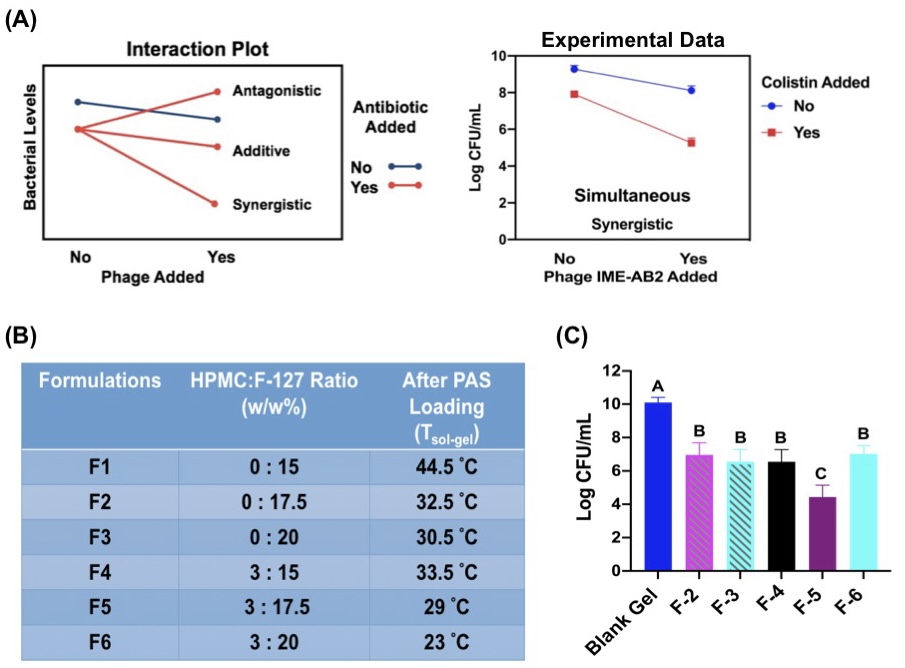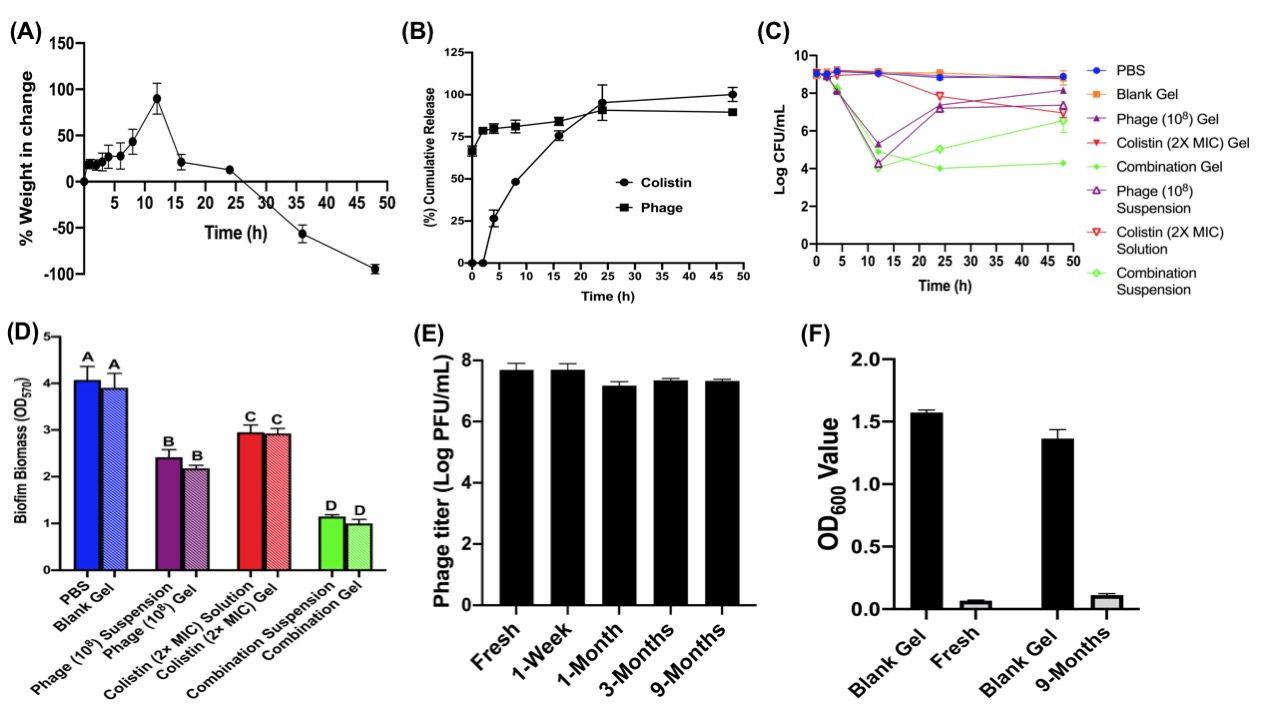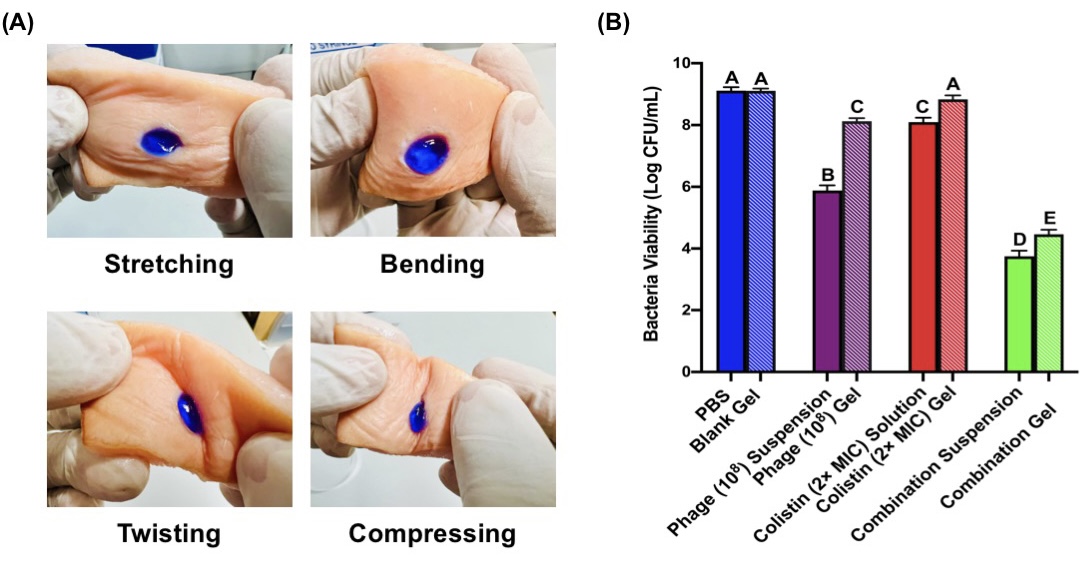Formulation and Delivery - Biomolecular
Category: Poster Abstract
A Thermosensitive Hydrogel Formulation of Phage and Colistin Combination for Management of Multidrug-Resistant <em>Acinetobacter baumannii </em>Wound Infection
(M1430-02-08) A Thermosensitive Hydrogel Formulation of Phage and Colistin Combination for Management of Multidrug-Resistant Acinetobacter baumannii Wound Infection
Monday, October 23, 2023
2:30 PM - 3:30 PM ET

Subhankar Mukhopadhyay, MS, PhD (he/him/his)
PhD Scholar
Chinese University of Hong Kong
Sha Tin, New Territories, Hong Kong- KT
Kenneth Kin Wah To (he/him/his)
Chinese University of Hong Kong
Hong Kong, Hong Kong - YL
Yannan Liu
Beijing Chao-Yang Hospital
Be, Beijing, China (People's Republic) - CB
Changqing Bai
Shenzhen University Clinical Medical Academy
Shenzhen, Guangdong, China (People's Republic) .jpg)
Sharon Leung, PhD (she/her/hers)
Assistant Professor
Chinese University of Hong Kong
Hong Kong, Hong Kong
Presenting Author(s)
Co-Author(s)
Main Author(s)
Purpose: Skin is the largest organ of the body and acts as a first line of defense against external pathogens [1]. The recent emergence of multidrug-resistant (MDR) bacteria, especially Acinetobacter baumannii, possess the highest threat to the healthcare system by delaying the recovery of skin and soft tissue infections [2]. Because of the advent of resistance phenotypes, commonly used antibiotics are unable to control these illnesses [3]. Finding alternate antibacterial strategies is, therefore, essential. Recently, bacteriophage (phage) therapy has emerged as a renewed strategy to combat MDR bacterial infections [4]. However, phage likely fails to evolve into a robust antimicrobial due to a number of drawbacks, for example, the generation of phage-resistant strains and the long-term storage stability in formulations [5]. Therefore, phage-antibiotic synergy (PAS) has been adopted as an effective treatment strategy to mitigate the occurrence of phage and/or antibiotic resistance and achieve maximum bacterial killing. The rationale for co-administering phages and antibiotics stems from an evolutionary assumption that two separate selective pressures are more successful in terms of killing and reducing the likelihood of resistance mutations. The primary aim of the current work is to create a stable and efficient PAS-incorporated thermosensitive hydrogel formulation to treat wound infections associated with A. baumannii in-vitro and ex-vivo.
Methods: Phage vB_AbaM-IME-AB2 (IME-AB2 in short) and colistin were employed as the model phage-antibiotic combination against MDR strain of A. baumannii, MDR-AB2. Antibacterial assay was conducted to confirm a mixture of 108 PFU/mL IME-AB2 phage and colistin concentration of 8 μg/mL (2× MIC) could achieve synergistic killing. Next, we developed a collection of PAS-loaded thermosensitive hydrogel formulations, containing a bioadhesive polymer hydroxypropyl methylcellulose (HPMC, 0 ‒ 3 w/w%) and a thermoresponsive non-ionic triblock copolymer Pluronic® F127 (15 ‒ 20 w/w%). Optimal PAS-gel formulations were determined based on solution-gel transition temperature (Tsol-gel) determination and bacterial killing efficiency. Further in-vitro characterization on the optimized gel formulation, including gel swelling and degradation study, phage and antibiotic release studies, and antibiofilm assay, were performed to check its applicability as antibacterial wound dressing to manage skin wound infections. Finally, an ex-vivo study was performed with porcine skin to evaluate its clinical potential.
Results: According to the interaction-plot method proposed by Liu et al. [6], the bacterial killing efficiency of the studied phage-colistin combination could synergistically reduce the bacterial population (Figure 1A). We then incorporated this PAS combination into six different binary hydrogels containing F-127 and HPMC at various ratios (F1‒F6) detailed in Figure 1B. Based on the Tsol-gel (Figure 1B) and bacterial killing efficiency (Figure 1C) data, the optimized gel (F5) matrix contained HPMC: F-127 = 3: 17.5 w/w%. It had a Tsol-gel of 29°C, which is near to human skin temperature and good for topical application. It possessed good swelling and degradation behavior (Figure 2A) and sustained the release of phage and colistin (Figure 2B) for a period of 48 h to effectively kill bacteria in the planktonic (Figure 2C) and biofilm states (Figure 2D). Long-term stability is the major concern for phage products. Phage viability in the hydrogel solutions stored at 4 °C was determined at specific times. Phage IME-AB2 was found to be stable in the gel solution for at least 9 months (Figure 2E) with no significant change in the overall antibacterial activity noted after storage (Figure 2F). The optimized gel formulation exhibited good in-situ gelation behavior and firmly attached to the wounded skin, as confirmed by the gel-compression study (Figure 3A) and capable of reducing the bacterial burden (~4.5-5 log) in infected skin in the ex-vivo model, being superior to the monotherapies (Figure 3B).
Conclusion: In conclusion, our study demonstrated that the IME-AB2 phage and colistin combination could synergistically kill MDR A. baumannii in both planktonic and biofilm states. Also, the development of PAS-loaded hydrogel formulation proved to be effective in terms of managing MDR-AB2-associated skin infection in-vitro and ex-vivo. For the PAS-hydrogel formulations, ex-vivo investigations in human skin wound infection models may be a useful tool to boost the chance of success for clinical translation. Moreover, further in-vivo experiments are required to confirm its relevance in clinical application.
References: 1. Lu, Y. et al. A physicochemical double-cross-linked gelatin hydrogel with enhanced antibacterial and anti-inflammatory capabilities for improving wound healing. Journal of Nanobiotechnology 20, 1-26 (2022).
2. Zurawski, D. V., Banerjee, J., Alamneh, Y. A., Shearer, J. P. & Demons, S. T. in Acinetobacter baumannii 271-287 (Springer, 2019).
3. Eliopoulos, G. M., Maragakis, L. L. & Perl, T. M. Acinetobacter baumannii: epidemiology, antimicrobial resistance, and treatment options. Clinical infectious diseases 46, 1254-1263 (2008).
4. Brives, C. & Pourraz, J. Phage therapy as a potential solution in the fight against AMR: obstacles and possible futures. Palgrave Communications 6, 1-11 (2020).
5. Yan, W. et al. Formulation strategies for bacteriophages to target intracellular bacterial pathogens. Advanced Drug Delivery Reviews 176, 113864 (2021).
6. Gu Liu, C. et al. Phage-antibiotic synergy is driven by a unique combination of antibacterial mechanism of action and stoichiometry. MBio 11, e01462-01420 (2020).
Acknowledgements: S. Mukhopadhyay is supported by the HKPFS provided by the University Grants Committee. The authors are thankful to the Beijing Institute of Microbiology and Epidemiology for their kind donation of bacterial strain MDR-AB2 and IME-AB2 phage tested in the present study. This work was funded by the University Grants Committee of Hong Kong (Ref. 14112921).
 Figure 1. (A) Interaction-plot approach to demonstrate synergism. (B) Gelling temperature (Tsol-gel) and (C) bacterial killing assay of six different PAS-loaded gel formulations. All values are expressed as means ± S.D, n = 3. Non-shared letters are representing significant differences (P < 0.05) whereas shared letters are representing no significant differences (P > 0.05).
Figure 1. (A) Interaction-plot approach to demonstrate synergism. (B) Gelling temperature (Tsol-gel) and (C) bacterial killing assay of six different PAS-loaded gel formulations. All values are expressed as means ± S.D, n = 3. Non-shared letters are representing significant differences (P < 0.05) whereas shared letters are representing no significant differences (P > 0.05). Figure 2. (A) Swelling and degradation profile, (B) percentage cumulative phage and colistin release profile, antibacterial effect in (C) planktonic and (D) biofilm states. (E) Stability of phage and (F) overall PAS antibacterial efficacy in optimized gel (F-5) after storage for 9 months at 4 °C. All values are expressed as means ± S.D, n = 3. Non-shared letters are representing significant differences (P < 0.05) whereas shared letters are representing no significant differences (P > 0.05).
Figure 2. (A) Swelling and degradation profile, (B) percentage cumulative phage and colistin release profile, antibacterial effect in (C) planktonic and (D) biofilm states. (E) Stability of phage and (F) overall PAS antibacterial efficacy in optimized gel (F-5) after storage for 9 months at 4 °C. All values are expressed as means ± S.D, n = 3. Non-shared letters are representing significant differences (P < 0.05) whereas shared letters are representing no significant differences (P > 0.05). Figure 3. (A) Pictures of the gel compression study (stretching, bending, twisting and compressing). (B) Ex-vivo bactericidal effect of phage, colistin and their combination in suspension and optimized gel-form. All values are expressed as means ± S.D, n = 3. Non-shared letters are representing significant differences (P < 0.05) whereas shared letters are representing no significant differences (P > 0.05).
Figure 3. (A) Pictures of the gel compression study (stretching, bending, twisting and compressing). (B) Ex-vivo bactericidal effect of phage, colistin and their combination in suspension and optimized gel-form. All values are expressed as means ± S.D, n = 3. Non-shared letters are representing significant differences (P < 0.05) whereas shared letters are representing no significant differences (P > 0.05).